ENVIRONMENT AND ENERGY
Innovative Passive Seismic Analyses for Exploration and Monitoring of Geothermal Resources
Principal Investigator:
Dr. Claudia Finger
Affiliation:
Fraunhofer Research Institution for Energy Infrastructures and Geothermal Systems (IEG), Bochum, Germany
Local Project ID:
seisgeotherm
HPC Platform used:
JUWELS CPU of JSC
Date published:
Abstract/Summary
Geothermal energy is vital for renewable power and heating. To improve project safety and efficiency, scientists employ various methods to understand subsurface processes. Monitoring earthquakes is key and reveals how the subsurface reacts to different factors. However, interpreting seismic recordings is challenging due to complex interactions and background noise. Underground processes are complicated by fluids and fault systems. Our project uses computer simulations to analyze seismic waves, enhancing our ability to pinpoint small earthquakes accurately. This helps understanding seismic triggers and reducing hazards. Additionally, we utilize recorded background noise to directly investigate subsurface structures, maximizing data insights.
Project Description
Introduction
Geothermal Energy is a key technology for renewable energy and heat provision. To support a safe and efficient development of geothermal projects, several geoscientific techniques should be combined to obtain amongst others knowledge about subsurface structures, mineralogy, fluid-content and pre-existing stresses to mitigate risks. Seismic monitoring is a key technology in geothermal projects since it allows insights into the subsurface structures and may detect responses of the reservoir to a number of influencing factors. Passive seismic analyses use the continuously recorded ambient seismic noise field and recorded micro-seismic events to explore and monitor the subsurface. However, standard seismic analysis methods face severe challenges in geothermal environments. Seismic events may be obscured by ambient and anthropogenic noise and subsurface geomechanical processes are complicated due to the influence of fluids and heat. Additionally, the increasing amount of recorded data enables in-depth analysis of these processes but also requires increased amounts of data handling and complicates the interpretation of results.
In seisgeotherm, we use the rotated staggered grid finite-difference code HeidimodX (Saenger et al., 2000) to simulate seismic wave propagation on the reservoir scale. We use the computing time on JUWELS to create (i) long time windows of ambient seismic noise datasets to benchmark three-component beamforming techniques (Löer et al., 2020) for imaging subsurface structures and (ii) improve location and characterisation accuracy for small-scale seismic events using time-reverse imaging (TRI; Finger and Saenger, 2021) techniques. Both challenges involve models on the reservoir scale with 800 - 2000 Mio grid points and runtimes of a half a day to multiple days which makes the use of HPC structures a requirement.
Results
Time-reverse imaging (TRI) is a waveform-based method for locating and characterising seismic events (e.g., Finger and Saenger, 2021). It uses time-reversed simulations of the seismic wavefield to converge the seismic energy on seismic event locations (Figure 1). Since TRI does not rely on the identification of events in the seismic traces, it is especially suited for quasi-simultaneous events and those with a low signal-to-noise ratio that often occur in geothermal sites. However, TRI has shown to be highly sensitive to the station distribution (Finger and Saenger, 2020). Here, we improved on the workflow to design an optimal station network for TRI and applied it to the site Weisweiler, North-Rhine Westphalia, Germany (Finger et al., 2023). More than 40 broadband stations have been deployed in the area to record the background seismicity and ambient noise. Deviations from the optimal station plan were necessary due to local conditions and relying on the cooperation from local citizens to offer their property for the installation. After the installation, we applied the improved workflow of sensitivity maps to the final station layout to investigate the location capability with TRI (Finger et al., 2023). Following this study, the potential to utilise deep geothermal resources and its associated hazards is investigated.

Figure 1: Total energy density imaging condition result of synthetic source locations (red circles) from time-reverse imaging applied to synthetic seismic recordings from dense surface receivers and deep borehole receivers (blue).
We designed a new approach to create fully synthetic realistic ambient noise waveform data from three-dimensional models. Using three-dimensional models and long recording times has the benefit of complete flexibility for receiver design, source distribution and velocity models. We used the created synthetic data to test and benchmark three-component Beamforming for ambient noise (B3AM). Beamforming compares theoretical phase shifts of waveforms with observed ones to retrieve the propagation direction and propagation speed of waves. The improvements made in B3AM include the analysis of all three components of the recorded wavefield and allows to identify and separate different wave types. We used B3AM to develop a new approach for estimating the depth of sudden velocity changes from Raleigh wave ellipticities (Finger and Löer, 2023). We expect this work to have great impact on the investigation of site amplification in sedimentary basins that is a significant factor in increasing seismic hazard.
References (project output)
Finger, C., Roth, M.P., Dietl, M., Gotowik, A, Engels, N., Harrington, R.M., Knapmeyer-Endrun, B., Reicherter, K., Oswald, T., Reinsch, T., and Saenger, E.H.: The Weisweiler passive seismological network: optimised for state-of-the-art location and imaging methods, ESSD, 15, 2655-2666, 2023, https://doi.org/10.5194/essd-15-2655-2023 .
Finger, C. and Löer, K.. Depth of Sudden Velocity Changes derived from Multi-Mode Rayleigh Waves. ESS Open Archive . November 22, 2023, https://essopenarchive.org/doi/full/10.22541/essoar.170067186.61826987 .
Finger, C. and Saenger, E.H.. Synthetic ambient seismic noise dataset for testing ambient-noise methods, Fraunhofer Fordatis, 2023, http://dx.doi.org/10.24406/fordatis/302
Additional References
Saenger. E.H., Gold, N., and Shapiro. S.A., Modeling the propagation of elastic waves using a modified finite-difference grid, Wave Motion, 31, no. 1, 77–92, 2000.
Löer, K., Toledo, T., Norini, G., Zhang, X., Curtis, A. and Saenger, E.H., Imaging the deep structures of the Los Humeros geothermal field, Mexico, using three-component ambient noise beamforming, Seismological Research Letters, 2020.
Finger, C. and Saenger, E.H.. Determination of the time-dependent moment tensor using time reverse imaging, Geophysics, 86, no. 2, KS63–KS77, 2021.
Finger, C. and Saenger, E.H., Sensitivity Maps for Time-Reverse Imaging: An Accuracy Study for the Los Humeros Geothermal Field (Mexico), Geophysical Journal International, 222, 231–246, 2020.